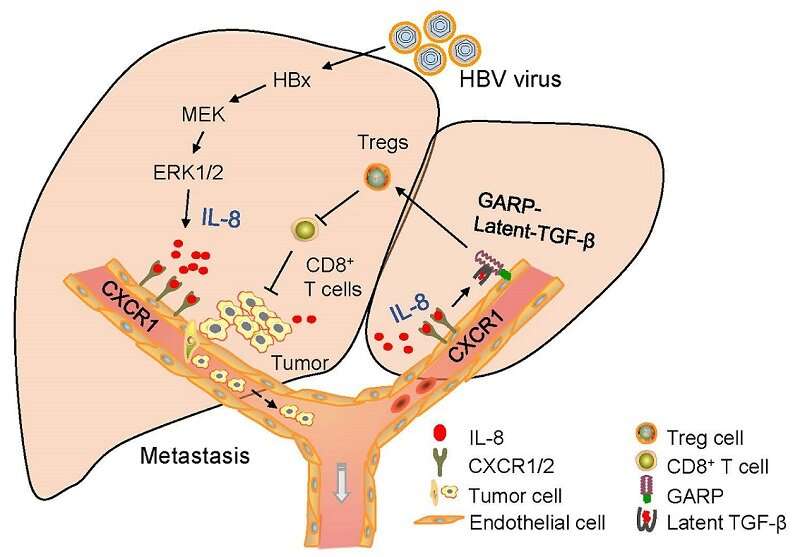
In China, about 70 million people are infected with hepatitis B virus (HBV), and more than 80% of liver cancer is caused by HBV.
HBV-associated hepatocellular carcinoma (HCC) is often accompanied by severe vascular invasion and portal vein tumor thrombus leading to a poor prognosis. However, the underlying mechanism of this disease remains obscure.
In a study published in Cancer Research, Prof. Yang Pengyuan and Prof. Wang Fan at the Institute of Biophysics (IBP) of the Chinese Academy of Sciences (CAS) revealed how HBV infection induced HCC venous metastasis and immune escape through a chemokine-based network.
The researchers first established a cytokines/chemokines array and screened the proinflammatory cytokine IL-8 as a potential target responsively to HBV infection. Multiple models and mechanistic study identified that HBV-induced IL-8 expression can be activated by HBx-mediated MEK-ERK signaling pathway, which enhanced permeability of the endothelium via endothelial CXCR1, the receptor of IL-8.
Based on the identification of IL-8-CXCR1 axis promoting tumor vascular metastasis in vivo, they then constructed a transgenic mouse that selectively express human CXCR1 in endothelial cells.
Interestingly, the IL-8-CXCR1 axis on the vascular endothelium dramatically increased liver tumorigenesis and metastasis, and the increase in lung metastasis was observed through overexpression of IL-8, but exogenous CXCR1 overexpression did not further enhance lung metastasis. Mechanistically, the IL-8-CXCR1 axis selectively induced GARP-latent-TGF-β in liver sinusoidal endothelial cells (LSECs) and subsequently provoked preferential regulatory T cell polarization to suppress antitumor immunity.
This study identifies a hepatitis B-induced IL-8/CXCR1/TGF-β signaling cascade that suppresses anti-tumor immunity and enhances metastasis in hepatocellular carcinoma, providing new potential targets for therapeutic intervention.
Liu Jia, Chinese Academy of Sciences

